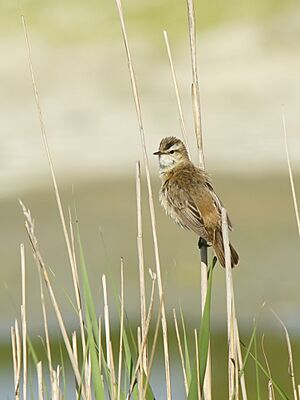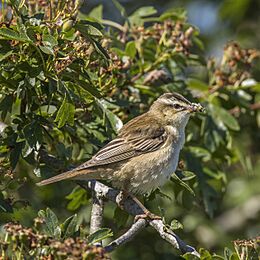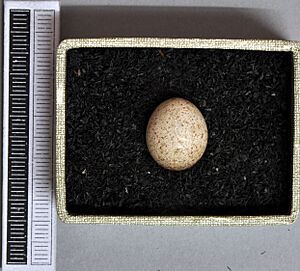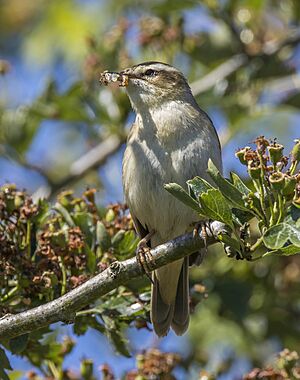Sedge warbler facts for kids
The sedge warbler (Acrocephalus schoenobaenus) is a small bird from the group called Old World warblers. It has a brown, streaky back and wings. You can easily spot it by the clear pale stripe above its eye, called a supercilium. Sedge warblers are migratory birds. They fly all the way across the Sahara desert! They breed in Europe and Asia and then spend winter in Africa. The male sedge warbler sings a fast, chattering song that often includes sounds from other birds. These birds mainly eat insects.
Quick facts for kids Sedge warbler |
|
|---|---|
|
|
|
| A sedge warbler at Otmoor RSPB reserve | |
| Conservation status | |
| Scientific classification | |
| Genus: |
Acrocephalus (bird)
|
| Species: |
schoenobaenus
|
 |
|
| Distribution map Breeding Passage Non-breeding |
|
| Synonyms | |
|
Motacilla schoenobaenus Linnaeus, 1758 |
|
Contents
What Does a Sedge Warbler Look Like?
This is a medium-sized warbler. It is about 11.5 to 13 centimeters (4.5 to 5 inches) long. It weighs around 12 grams (0.4 ounces). Its back and wings are streaky brown. Its belly is pale. The lower back (rump) is a warm brown color and has no streaks. This makes it look different from its duller wings.
The sedge warbler has a flat forehead. Its head is streaked with black. It has a strong, pointed beak. A bright whitish stripe above its eye is very noticeable. Its legs are greyish.
How to Tell Males, Females, and Young Birds Apart
Male and female sedge warblers look the same. But bird experts can tell them apart when they catch them for ringing. This is done by looking for special signs during breeding season.
Young sedge warblers have dark spots on their chest. They can sometimes be confused with other warblers. The oldest sedge warbler ever found was in Finland. It lived to be 10 years and 1 month old! Most sedge warblers live for about 2 years.
The Sedge Warbler's Song
The sedge warbler's song is very fast and chattering. It includes sweet sounds and even copies other birds. Each song is unique because the bird puts phrases together in a random order. Male sedge warblers with the most varied songs often attract more females.
Where Sedge Warblers Live and Travel
Sedge warblers live in a very large area. There are between 8.8 million and 15 million of these birds in Europe alone. Their population numbers can change. This is often due to how much rain falls in their winter homes. The sedge warbler is not considered an endangered bird.

These birds breed across Europe and parts of Asia. They are migratory. After breeding, they eat a lot to get ready. Then they fly quickly across southern Europe and the Sahara desert. This happens from August to September. Studies show that sedge warblers often return to the same winter spots year after year.
All sedge warblers spend winter in Africa, south of the Sahara desert. They can be found from Senegal in the west to Ethiopia in the east. They also go as far south as South Africa and northern Namibia. The path they take to their winter homes depends on where they breed. For example, birds from the United Kingdom often end up in southern Europe.
Losing wetland areas where they stop to eat during migration is a problem. Also, the Sahara desert is growing. These things can threaten the sedge warbler population. Birds start leaving Africa in late February. They eat a lot at wetlands before and after crossing the Sahara. They arrive in Europe starting in March.
Unlike some other warblers, the sedge warbler lives in many different climates. It can live in cool, cloudy, and wet places. Even though it is often found in wetlands, it can breed far from water. During breeding season, you can find them in reedbeds, bushes, ditches, and even in farm fields. In Africa, they use reeds, tall grass, and other plants in wetlands. They can live at high altitudes in Ethiopia.
Sedge Warbler Behaviour
Reproduction and Life Cycle
Male sedge warblers start singing just a few hours after they arrive at their breeding spot. They sing from a high perch, like a reed stem or bush. They also sing during short flights. During these "song-flights," the bird flies up a few meters. Then it circles and slowly floats down, often with its wings held up like a 'V'. The song helps them find a mate. Once a mate is found, the male stops singing. They make a "chirr" or "kerr" sound as a contact call. If they are alarmed, they repeat these calls quickly.
Studies show that males who arrive early get the best breeding spots. Males often mate with more than one female. If a female's eggs or chicks are eaten by predators, she might leave the male. Then the male will start singing again to find another female.
The male protects a small area of land, about 0.1 to 0.2 hectares. The female builds the nest. It is usually in plants on the ground or up to 50 cm (20 inches) high. The nest is shaped like a cup. It is made of grass, stems, leaves, and spider webs on the outside. Inside, it has a soft layer of reed flowers, animal hair, and plant fluff. The nest is woven around strong plant stems.
The female lays 3 to 5 greenish-yellow eggs with brown spots. Each egg is about 18 x 13 mm (0.7 x 0.5 inches) and weighs 1.6 grams. The female sits on the eggs for 14 days to keep them warm. When the chicks hatch, they are naked and helpless. Both parents take care of the chicks. The young birds leave the nest after 13 to 14 days. After leaving the nest, young sedge warblers still ask their parents for food for 1 to 2 weeks.
What Sedge Warblers Eat
Sedge warblers eat many kinds of insects. These include mayflies, dragonflies, grasshoppers, bugs, lacewings, moths, beetles, and flies. They also eat some plant material, like elderberries and blackberries. In their winter homes, they eat small insects and berries from the toothbrush tree.
Before they migrate in late July, sedge warblers look for places with lots of plum-reed aphids. They stay there longer to eat and get fat. Some birds can fly long distances, like from southern England to northern France, just to find food before their big migration. Birds that build up the most fat can fly non-stop from Africa to southern Britain! Some birds can even double their normal weight to get ready for migration. Lighter birds have to stop more often during their journey.
Sedge warblers look for food in low, thick plants. This includes reeds and rushes, but also farm fields and bushes. They pick insects from plants while sitting or hovering. They also catch flying insects as they move between perches. Sedge warblers often hop between plant stems. They pick insects from under leaves. They also use the cooler temperatures around sunrise and sunset. This makes their prey less active and easier to catch.





